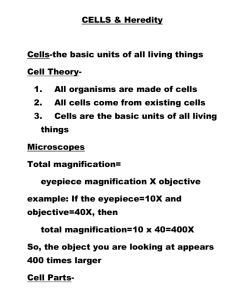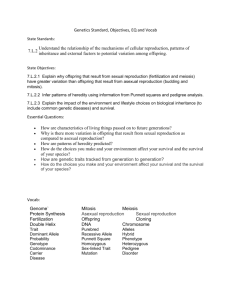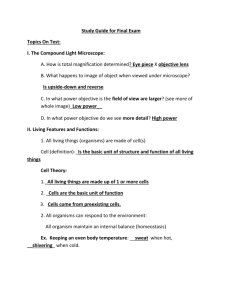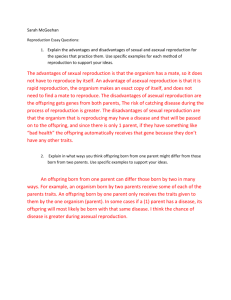Spring Semester Exam Review
advertisement
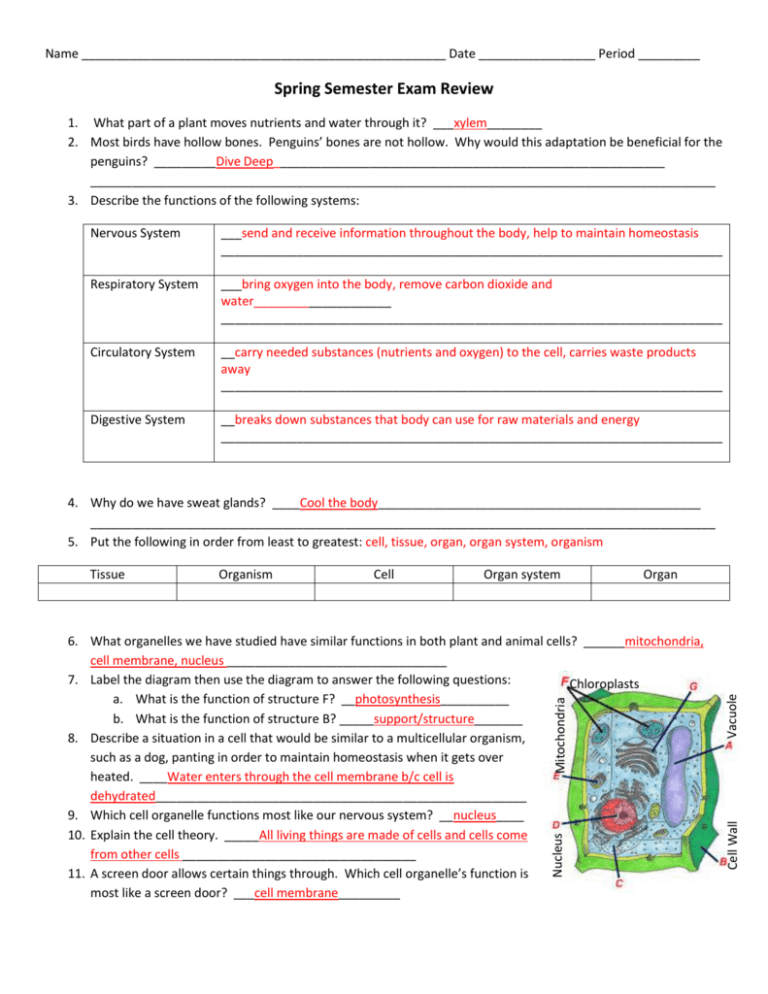
Name _____________________________________________________ Date _________________ Period _________ Spring Semester Exam Review 1. What part of a plant moves nutrients and water through it? ___xylem________ 2. Most birds have hollow bones. Penguins’ bones are not hollow. Why would this adaptation be beneficial for the penguins? _________Dive Deep_________________________________________________________ ___________________________________________________________________________________________ 3. Describe the functions of the following systems: Nervous System ___send and receive information throughout the body, help to maintain homeostasis _________________________________________________________________________ Respiratory System ___bring oxygen into the body, remove carbon dioxide and water____________________ _________________________________________________________________________ Circulatory System __carry needed substances (nutrients and oxygen) to the cell, carries waste products away _________________________________________________________________________ Digestive System __breaks down substances that body can use for raw materials and energy _________________________________________________________________________ 4. Why do we have sweat glands? ____Cool the body_______________________________________________ ___________________________________________________________________________________________ 5. Put the following in order from least to greatest: cell, tissue, organ, organ system, organism Cell Organ system Organ Nucleus Mitochondria 6. What organelles we have studied have similar functions in both plant and animal cells? ______mitochondria, cell membrane, nucleus ________________________________ 7. Label the diagram then use the diagram to answer the following questions: Chloroplasts a. What is the function of structure F? __photosynthesis__________ b. What is the function of structure B? _____support/structure_______ 8. Describe a situation in a cell that would be similar to a multicellular organism, such as a dog, panting in order to maintain homeostasis when it gets over heated. ____Water enters through the cell membrane b/c cell is dehydrated______________________________________________________ 9. Which cell organelle functions most like our nervous system? __nucleus____ 10. Explain the cell theory. _____All living things are made of cells and cells come from other cells __________________________________ 11. A screen door allows certain things through. Which cell organelle’s function is most like a screen door? ___cell membrane_________ Vacuole Organism Cell Wall Tissue 12. Describe what the genetic information of the offspring of cells that come from one type of tissue in the body would be. ________They are genetically the same ________________________________________________ __________________________________________________________________________________________ 13. Describe the daughter cells (offspring) of an asexually reproducing organism. ___the same number of genes__ ___________________________________________________________________________________________ 14. Give some examples to prove Mendel’s theory of inheritance. _____2 striped flowers have offspring that are also striped_________________________________________________________________________ 15. Compare Genetics and Heredity using the T-chart below: Genetics Study of genes/heredity Heredity Study of how genes are passed from one generation to the next 16. What type of reproduction would result in the most diverse offspring? ___Sexual reproduction_____________ Give some examples ___bees bringing pollen from flower to flower, two children from same parents having different colored eyes__________________________________________________________ 17. Fill in the following T-chart: Asexual Reproduction Sexual Reproduction Disadvantage No genetic variation Advantage One parent Two parents Genetic variation 18. Sequence the following parts from largest to smallest: nucleus, chromosome, DNA, gene Gene Chromosome Nucleus DNA 19. Label the cell parts. Which location would genetic information be located? nucleus 1. mitochondria 2. cell membrane 3. nucleus 4. vacuole 5. cytoplasm 20. Genes are passed from parent to offspring on _____chromosomes______. 21. If a tree is cut down in a dense forest, what is going to happen in the opening that is created as a result? ______ __saplings and small plants will thrive in the sun light______________________ 22. The role of the first species in an area, during succession is to:change bare habitat into one suitable for other organisims. 23. A species that is responsible for primary succession is likely able to do what?____carry out photoynthesis____. 24. To show succession is occurring on bare rock, scientists would measure_soil depth_______. 25. Bermuda grass produces tiny seeds that are spread and pollinated by __the wind_____. 26. Describe the characteristics of a compound leaf____many leaflets branching off a central stem_____. 27. Explain why a bright colored detachable tale is a good adaptation for some lizards__predators are more likely to grab them by the tail, tail drops off, lizard can escape______________________________________. 28. Some poisonous frogs have bright coloring, why would this be an advantage?__serve as a warning to hungry predators__. 29. A plant that produces its own plantlets has many advantages, name two__does not have to rely on animals, insects or wind for pollination or seed dispersal_________________________________________. 30. Some animals produce many offspring at one time, some only produce one at a time. What are the advantages of having fewer offspring?_____parents can pay more attention to each offspring_______________________. 31. Some moths have brown bodies and wings; some have white bodies and wings. What would happen in an area if all the trees with white bark were cut down and only brown bark trees remain?__more brown moths will survive than with moths because predators will be able to spot the whit moths more easily. Over time, where will be no white moths in the area____________________________________________________. 32. Use the dichotomous key to identify leaf A Magnolia 33. A prairie ecosystem contains grass, mice, prairie dog, snakes, and hawks, draw an energy pyramid for this ecosystem. Hawks Snake prairie dog / mice Grass 34. Diagram the flow of energy in an ecosystem that includes: water, plants, snails, fish. Sun – plant – fish Sun – plant – snail 35. In the grasslands, both deer and wolves live together. What is the role of the wolf?__Predator___. What is the role of the deer?_Prey_____. 36. Crickets find mates by chirping, crickets that cannot chirp are less likely to find a mate and reproduce, and there are fewer crickets that cannot chirp. What is this an example of?__natural selection_______________. 37. Some frogs can dig burrows into the mud during hot summer months and stay there up to 10 months. Why would this be beneficial ?___conserve water_________________. 38. Diagram and explain positive and negative turgor pressure 39. Diagram and explain positive and negative geotropism 40. Identify if the following compounds are organic or inorganic AND how many elements they have. NClOO - inorganic 3 NaHC – organic 3 HOOHCCL – organic 4 41. Identify the following has either an element or compound Carbon - element Water - compound Phosphorus - element Carbon Dioxide – compound 42. List the characteristics of a metal Shiny luster, malleable, ductile, good conductor, high melting point 43. List the characteristics of a non-metal Dull luster, good insulator, brittle, low melting point 44. List the characteristics of a metalloid Solid, both shiny and dull luster, not ductile, not malleable, semiconductors 45. 46. 47. 48. How do you calculate speed?__distance divided by time________________________________ How do you calculate work?___force times distance__________________________________ A man drives 350 miles for 8 hours, how fast was he driving?____43.75 mph________ Give possible explanations of what is happening in these speed story graphs B A A…Object started coming towards you at a steady speed, paused and waited, then continued. B…Object started moving away from you, paused and waited then continued on at steady speed C D C…Object move away from you, paused, returned to you D…Object stayed where it was without moving 49. Give the energy transformations for the following: Split an atom to heat steam – nuclear to heat Burn a candle – chemical to heat Using a hot plate to warm water – electrical to heat Distance 50. What is the average speed of a remote controlled car, represented in the graph below? 1000 cm/s




